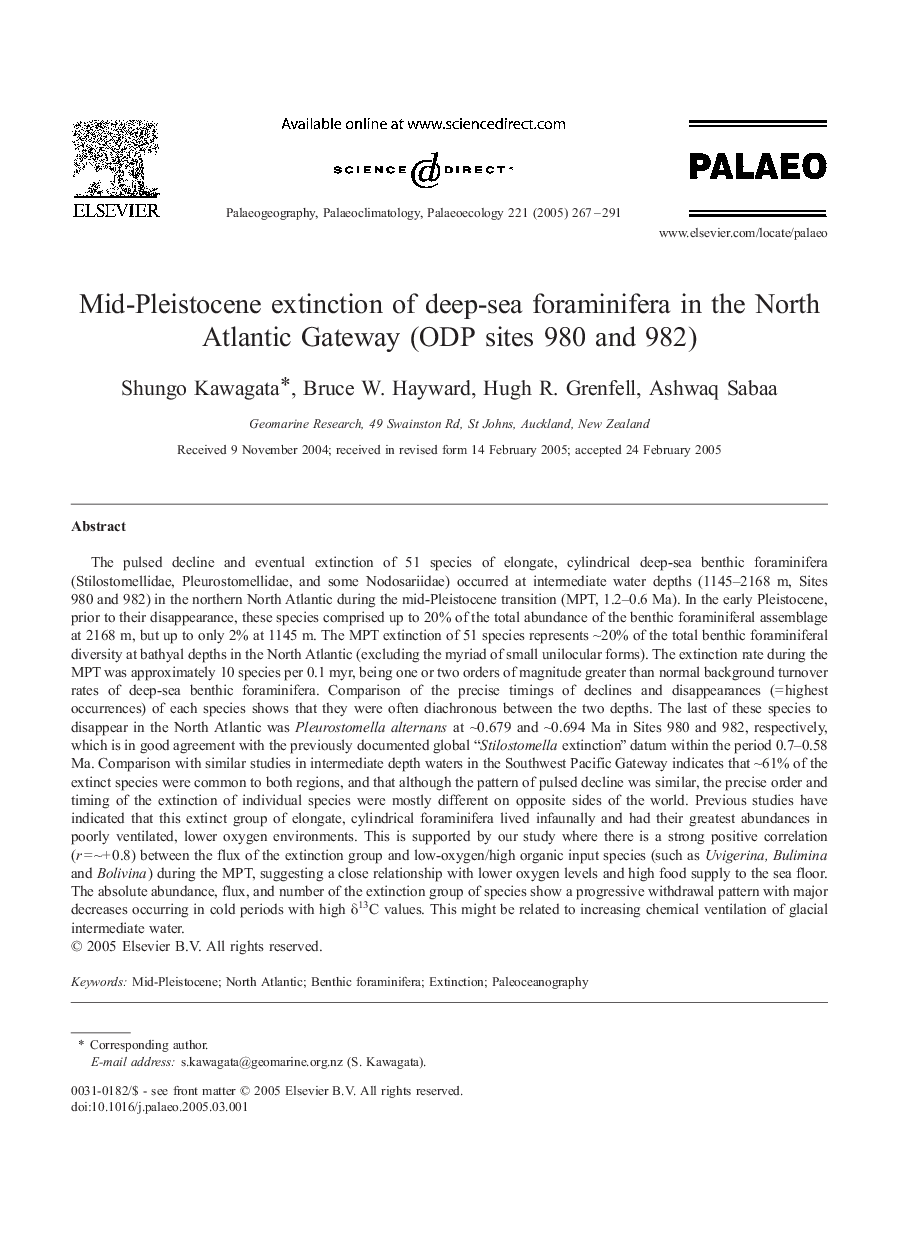| کد مقاله | کد نشریه | سال انتشار | مقاله انگلیسی | نسخه تمام متن |
|---|---|---|---|---|
| 9463045 | 1622394 | 2005 | 25 صفحه PDF | دانلود رایگان |
عنوان انگلیسی مقاله ISI
Mid-Pleistocene extinction of deep-sea foraminifera in the North Atlantic Gateway (ODP sites 980 and 982)
دانلود مقاله + سفارش ترجمه
دانلود مقاله ISI انگلیسی
رایگان برای ایرانیان
کلمات کلیدی
موضوعات مرتبط
مهندسی و علوم پایه
علوم زمین و سیارات
فرآیندهای سطح زمین
پیش نمایش صفحه اول مقاله

چکیده انگلیسی
The pulsed decline and eventual extinction of 51 species of elongate, cylindrical deep-sea benthic foraminifera (Stilostomellidae, Pleurostomellidae, and some Nodosariidae) occurred at intermediate water depths (1145-2168 m, Sites 980 and 982) in the northern North Atlantic during the mid-Pleistocene transition (MPT, 1.2-0.6 Ma). In the early Pleistocene, prior to their disappearance, these species comprised up to 20% of the total abundance of the benthic foraminiferal assemblage at 2168 m, but up to only 2% at 1145 m. The MPT extinction of 51 species represents â¼20% of the total benthic foraminiferal diversity at bathyal depths in the North Atlantic (excluding the myriad of small unilocular forms). The extinction rate during the MPT was approximately 10 species per 0.1 myr, being one or two orders of magnitude greater than normal background turnover rates of deep-sea benthic foraminifera. Comparison of the precise timings of declines and disappearances (= highest occurrences) of each species shows that they were often diachronous between the two depths. The last of these species to disappear in the North Atlantic was Pleurostomella alternans at â¼0.679 and â¼0.694 Ma in Sites 980 and 982, respectively, which is in good agreement with the previously documented global “Stilostomella extinction” datum within the period 0.7-0.58 Ma. Comparison with similar studies in intermediate depth waters in the Southwest Pacific Gateway indicates that â¼61% of the extinct species were common to both regions, and that although the pattern of pulsed decline was similar, the precise order and timing of the extinction of individual species were mostly different on opposite sides of the world. Previous studies have indicated that this extinct group of elongate, cylindrical foraminifera lived infaunally and had their greatest abundances in poorly ventilated, lower oxygen environments. This is supported by our study where there is a strong positive correlation (r = â¼+ 0.8) between the flux of the extinction group and low-oxygen/high organic input species (such as Uvigerina, Bulimina and Bolivina) during the MPT, suggesting a close relationship with lower oxygen levels and high food supply to the sea floor. The absolute abundance, flux, and number of the extinction group of species show a progressive withdrawal pattern with major decreases occurring in cold periods with high δ13C values. This might be related to increasing chemical ventilation of glacial intermediate water.
ناشر
Database: Elsevier - ScienceDirect (ساینس دایرکت)
Journal: Palaeogeography, Palaeoclimatology, Palaeoecology - Volume 221, Issues 3â4, 9 June 2005, Pages 267-291
Journal: Palaeogeography, Palaeoclimatology, Palaeoecology - Volume 221, Issues 3â4, 9 June 2005, Pages 267-291
نویسندگان
Shungo Kawagata, Bruce W. Hayward, Hugh R. Grenfell, Ashwaq Sabaa,